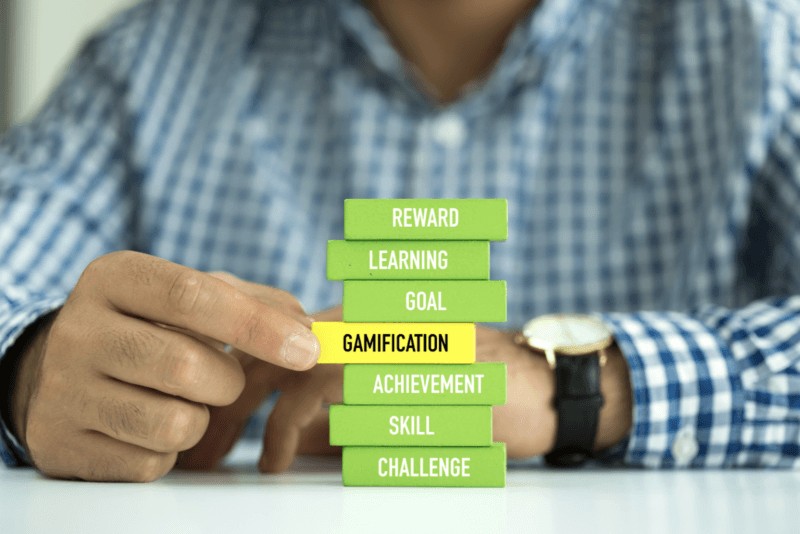Gamification in learning involves using game-design elements and game principles in learning environments to enhance engagement and motivation; LEARNS.EDU.VN offers comprehensive insights into this transformative approach. This strategy enhances learning by making it more engaging, interactive, and enjoyable, ultimately improving knowledge retention and application, integrating game mechanics, game-based elements, and reward systems. Discover how to leverage gamification strategies to revolutionize your educational journey and achieve enhanced learning outcomes.
1. Understanding Gamification in Learning
Gamification in learning transforms the educational landscape by integrating game design elements into the learning process. This approach, supported by research from institutions, aims to enhance engagement, motivation, and knowledge retention among learners of all ages. Let’s delve deeper into what gamification entails and its potential benefits.
1.1. Defining Gamification
Gamification involves using game elements and game-design principles in non-game contexts. In education, this means incorporating elements like points, badges, leaderboards, challenges, and narratives into learning activities to make them more engaging and enjoyable. The goal is to leverage the motivational power of games to encourage learners to participate actively and achieve learning objectives effectively.
1.2. The Core Principles of Gamification
Several core principles underpin effective gamification in learning:
- Motivation: Gamification taps into intrinsic and extrinsic motivation by providing rewards and recognition for achievements.
- Engagement: Game elements capture learners’ attention and keep them actively involved in the learning process.
- Feedback: Immediate and constructive feedback helps learners understand their progress and identify areas for improvement.
- Progression: Clear learning paths and milestones provide a sense of accomplishment and encourage continued effort.
- Challenge: Well-designed challenges promote problem-solving skills and critical thinking.
- Fun: Making learning fun creates a positive emotional association that enhances retention and recall.
1.3. Key Game Elements Used in Learning
Here are some common game elements used in gamification:
| Game Element | Description | Example |
|---|---|---|
| Points | Awarded for completing tasks or achieving specific goals; can be accumulated and used for rewards. | Earning points for completing quizzes or participating in discussions. |
| Badges | Virtual awards that recognize specific achievements or skills. | Receiving a badge for mastering a particular concept or skill. |
| Leaderboards | Display rankings of learners based on their performance; promote friendly competition. | Ranking students based on their quiz scores or project completion rates. |
| Challenges | Tasks or activities that require learners to apply their knowledge and skills to solve problems. | Solving a complex problem or completing a project with specific constraints. |
| Levels | Progression through different stages of learning, each with increasing difficulty. | Advancing to higher levels after completing modules and assessments. |
| Narratives | Storylines or scenarios that provide context and purpose for learning activities. | Learning about historical events through an interactive story. |
| Avatars | Digital representations of learners within the game environment. | Customizing an avatar to represent oneself in a virtual classroom. |
| Virtual Currency | Used to purchase items or unlock features within the learning environment. | Earning virtual currency for completing tasks and using it to access bonus content. |


1.4. Benefits of Gamification in Learning
Gamification offers numerous benefits for learners and educators alike:
- Increased Motivation: Game elements such as rewards, recognition, and competition can significantly boost learners’ motivation to engage with the material.
- Enhanced Engagement: Gamification makes learning more interactive and enjoyable, capturing learners’ attention and keeping them actively involved.
- Improved Knowledge Retention: The interactive nature of gamified learning experiences helps learners retain information more effectively.
- Development of Problem-Solving Skills: Challenges and puzzles encourage learners to think critically and develop problem-solving abilities.
- Positive Learning Environment: Gamification creates a fun and supportive environment that fosters a love of learning.
1.5. Research and Studies Supporting Gamification
Numerous studies support the effectiveness of gamification in learning. According to research by Trimmer and Casillas (2020), incorporating game elements into educational settings significantly improves student engagement and academic performance. A study by Kapp (2012) highlights that gamification increases learner motivation, resulting in better knowledge retention.
2. Implementing Gamification Strategies in Education
Integrating gamification into education requires careful planning and thoughtful design. Here’s a step-by-step guide to help educators implement effective gamification strategies:
2.1. Defining Learning Objectives
The first step in implementing gamification is to clearly define the learning objectives. What specific knowledge, skills, or behaviors do you want learners to acquire? Aligning the game elements with these objectives ensures that the gamified activities support meaningful learning.
2.2. Identifying Target Audience
Understanding your target audience is crucial for designing relevant and engaging gamified experiences. Consider factors such as age, interests, learning styles, and prior knowledge. Tailor the game elements and challenges to resonate with your learners’ specific needs and preferences.
2.3. Choosing Appropriate Game Elements
Select game elements that align with your learning objectives and appeal to your target audience. Consider the following factors:
- Relevance: Choose elements that directly support the learning content.
- Simplicity: Keep the rules and mechanics simple and easy to understand.
- Balance: Balance competition and collaboration to cater to different learning styles.
- Variety: Offer a mix of game elements to keep learners engaged and motivated.
2.4. Designing Engaging Activities
Design activities that are both challenging and enjoyable. Incorporate elements of storytelling, exploration, and discovery to create a more immersive learning experience. Provide clear instructions and guidelines to ensure that learners understand the goals and rules of each activity.
2.5. Providing Feedback and Recognition
Regular feedback and recognition are essential for keeping learners motivated and engaged. Provide immediate feedback on their progress, highlighting areas of strength and areas for improvement. Offer rewards, badges, and other forms of recognition for achieving milestones and demonstrating mastery of the material.
2.6. Integrating Technology Tools
Leverage technology tools to facilitate the implementation of gamification strategies. Utilize learning management systems (LMS), online platforms, and educational apps to create interactive and engaging learning experiences. Consider using tools that offer built-in gamification features, such as points, badges, and leaderboards.
2.7. Examples of Successful Gamification Implementations
Here are some examples of how gamification has been successfully implemented in education:
- Language Learning: Apps like Duolingo use gamified lessons, points, and leaderboards to motivate learners to practice and improve their language skills.
- Mathematics: Online platforms like Khan Academy use points, badges, and progress bars to track learners’ progress and encourage them to master mathematical concepts.
- Science Education: Games like “Kerbal Space Program” engage learners in physics and engineering principles by challenging them to design and launch rockets.
- Corporate Training: Companies use gamified simulations and scenarios to train employees in areas such as customer service, sales, and leadership skills.
2.8. Measuring the Impact of Gamification
To determine the effectiveness of your gamification strategies, it’s essential to measure their impact on learning outcomes. Track metrics such as:
- Engagement: Monitor participation rates, time spent on activities, and learner feedback.
- Performance: Assess improvements in test scores, project grades, and skill development.
- Motivation: Gauge learners’ attitudes toward the material and their willingness to participate in future learning activities.
- Retention: Measure how well learners retain information over time.
3. Gamification in Various Educational Settings
Gamification is versatile and can be applied across different educational contexts, from K-12 classrooms to higher education institutions and corporate training programs.
3.1. Gamification in K-12 Education
In K-12 education, gamification can transform traditional classrooms into engaging learning environments. Teachers can use game elements to motivate students, enhance their understanding of concepts, and promote a positive attitude toward learning.
- Classroom Management: Use points and rewards to encourage positive behavior and participation.
- Subject-Specific Learning: Create games and activities that reinforce key concepts in subjects like math, science, and language arts.
- Collaborative Projects: Design group projects that incorporate elements of competition and cooperation.
- Assessment Tools: Use gamified quizzes and tests to assess student learning in an engaging way.
3.2. Gamification in Higher Education
Gamification can also be highly effective in higher education, where it can motivate students to engage with challenging material, develop critical thinking skills, and prepare for their future careers.
- Online Courses: Incorporate game elements into online courses to increase student engagement and retention.
- Research Projects: Design research projects that incorporate elements of exploration, discovery, and collaboration.
- Simulations: Use gamified simulations to provide students with hands-on experience in their fields of study.
- Career Development: Create gamified career development programs that help students build essential skills and prepare for the workforce.
3.3. Gamification in Corporate Training
In corporate training, gamification can improve employee engagement, knowledge retention, and job performance. Companies can use game elements to motivate employees, enhance their skills, and promote a culture of continuous learning.
- Onboarding Programs: Use gamified onboarding programs to introduce new employees to the company’s culture, values, and policies.
- Skill Development: Create gamified training modules that help employees develop essential skills in areas such as leadership, communication, and problem-solving.
- Compliance Training: Use gamified simulations to train employees on compliance topics such as ethics, safety, and data privacy.
- Sales Training: Design gamified sales training programs that help employees improve their sales techniques and close more deals.
3.4. Real-World Examples of Gamification in Education and Training
| Setting | Example | Description |
|---|---|---|
| K-12 Education | Classcraft | A platform that transforms classrooms into role-playing games, where students earn points for positive behavior and completing assignments. |
| Higher Education | University of Michigan’s “GradeCraft” | A learning management system that allows students to choose their assignments and track their progress through a game-like interface. |
| Corporate Training | Deloitte Leadership Academy | A gamified training program that uses challenges, badges, and leaderboards to engage employees and promote leadership development. |
| Language Learning | Duolingo | A language learning app that uses gamified lessons, points, and leaderboards to motivate learners to practice and improve their language skills. |
| Medical Education | Level Ex | A mobile game that allows medical professionals to practice and improve their skills through realistic simulations and challenges. |
4. Overcoming Challenges in Gamification
While gamification offers many benefits, it’s essential to be aware of potential challenges and how to address them.
4.1. Avoiding Trivialization
One of the main concerns is that gamification can trivialize learning if the game elements are not aligned with the learning objectives. To avoid this, ensure that the game elements directly support the learning content and reinforce key concepts.
4.2. Ensuring Inclusivity
Some learners may not be motivated by competition or rewards. Design your gamification strategies to be inclusive and cater to different learning styles and preferences. Offer a variety of activities and challenges to appeal to a wide range of learners.
4.3. Managing Time and Resources
Implementing gamification can be time-consuming and require significant resources. Plan your gamification strategies carefully and prioritize activities that will have the greatest impact on learning outcomes. Consider using existing technology tools and platforms to streamline the implementation process.
4.4. Maintaining Engagement
Keeping learners engaged over the long term can be challenging. Regularly update your gamification strategies and introduce new game elements to maintain interest and motivation. Soliciting feedback from learners and making adjustments based on their suggestions can also help sustain engagement.
4.5. Ethical Considerations
Be mindful of the ethical implications of gamification, such as the potential for manipulation or coercion. Ensure that learners have autonomy and choice in their participation in gamified activities. Avoid using game elements that could create feelings of anxiety, pressure, or exclusion.
5. The Future of Gamification in Learning
The future of gamification in learning looks promising, with ongoing advancements in technology and a growing understanding of how game elements can be used to enhance education and training.
5.1. Emerging Trends in Gamification
- Personalized Learning: Gamification is becoming more personalized, with adaptive learning systems that tailor the game elements and challenges to individual learners’ needs and preferences.
- Augmented Reality (AR) and Virtual Reality (VR): AR and VR technologies are being used to create immersive and interactive gamified learning experiences.
- Artificial Intelligence (AI): AI is being used to develop intelligent tutoring systems that provide personalized feedback and support to learners.
- Blockchain Technology: Blockchain is being used to create secure and transparent systems for tracking learners’ achievements and awarding digital credentials.
5.2. Predictions for the Future of Gamification
- Gamification will become more integrated into mainstream education and training practices.
- The use of AR and VR technologies will create more immersive and engaging learning experiences.
- AI-powered tutoring systems will provide personalized support to learners and adapt to their individual needs.
- Blockchain technology will be used to create secure and transparent systems for recognizing and validating learners’ achievements.
5.3. The Role of LEARNS.EDU.VN in the Future of Gamification
LEARNS.EDU.VN is committed to staying at the forefront of gamification trends and providing educators and learners with the resources and support they need to succeed. The platform offers a wealth of information, tools, and best practices for implementing effective gamification strategies in various educational settings.
- Comprehensive Resources: Access a wide range of articles, guides, and tutorials on gamification.
- Expert Insights: Learn from industry experts and thought leaders who are shaping the future of gamification.
- Community Support: Connect with other educators and learners who are passionate about gamification.
- Innovative Tools: Explore cutting-edge tools and platforms that can help you implement gamification strategies effectively.
6. Practical Tips for Creating Effective Gamified Learning Experiences
To create truly effective gamified learning experiences, consider these practical tips:
- Start Small: Begin with simple gamification strategies and gradually introduce more complex elements as you gain experience.
- Seek Feedback: Regularly solicit feedback from learners and make adjustments based on their suggestions.
- Iterate and Improve: Continuously evaluate your gamification strategies and make improvements based on the data you collect.
- Stay Informed: Keep up with the latest trends and best practices in gamification.
- Be Creative: Don’t be afraid to experiment and try new things.
7. Call to Action
Ready to transform your learning environment with gamification? Visit LEARNS.EDU.VN today to explore our comprehensive resources, connect with experts, and discover innovative tools that can help you create engaging and effective gamified learning experiences.
7.1. Explore LEARNS.EDU.VN for More Insights
At LEARNS.EDU.VN, we understand the challenges learners face in finding reliable and engaging educational resources. We also know that educators are constantly seeking effective methods to motivate and inspire their students. That’s why we offer a wide range of articles, guides, and resources designed to help you leverage the power of gamification to enhance learning outcomes.
7.2. Connect with Our Experts
Our team of experienced educators and learning designers is passionate about gamification and its potential to transform education. Connect with our experts to get personalized guidance, advice, and support as you implement gamification strategies in your own learning environment.
7.3. Discover Innovative Tools
Explore our curated selection of innovative tools and platforms that can help you create engaging and effective gamified learning experiences. From learning management systems with built-in gamification features to specialized apps and platforms, we have the resources you need to succeed.
Contact Us:
- Address: 123 Education Way, Learnville, CA 90210, United States
- WhatsApp: +1 555-555-1212
- Website: LEARNS.EDU.VN
8. Frequently Asked Questions (FAQs) About Gamification in Learning
Here are some frequently asked questions about gamification in learning:
-
What Is Gamification In Learning?
Gamification in learning involves using game design elements and game principles in learning environments to enhance engagement and motivation.
-
Why is gamification important in education?
Gamification makes learning more engaging, interactive, and enjoyable, leading to improved knowledge retention and application.
-
What are the key elements of gamification?
Key elements include points, badges, leaderboards, challenges, narratives, and rewards.
-
How can I implement gamification in my classroom?
Start by defining learning objectives, identifying your target audience, and choosing appropriate game elements.
-
Is gamification suitable for all age groups?
Yes, gamification can be adapted for learners of all ages, from K-12 students to adults in corporate training.
-
What are some real-world examples of gamification in education?
Examples include Duolingo for language learning, Khan Academy for mathematics, and Classcraft for classroom management.
-
How can I measure the impact of gamification on learning outcomes?
Track metrics such as engagement, performance, motivation, and retention.
-
What are the challenges of gamification?
Challenges include avoiding trivialization, ensuring inclusivity, managing time and resources, and maintaining engagement.
-
What is the future of gamification in learning?
The future includes personalized learning, AR/VR integration, AI-powered tutoring, and blockchain-based credentialing.
-
Where can I learn more about gamification in education?
Visit learns.edu.vn for comprehensive resources, expert insights, and innovative tools.
